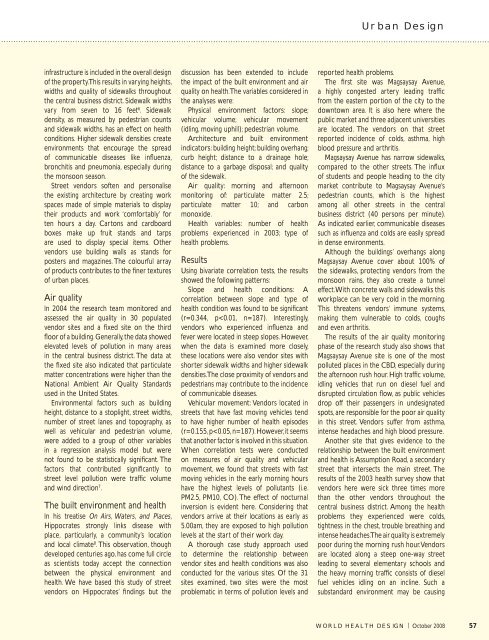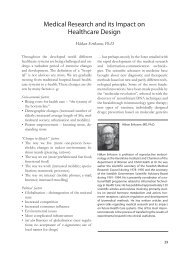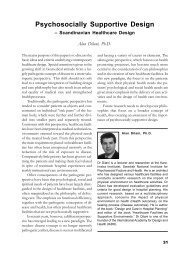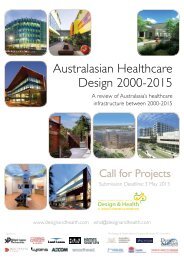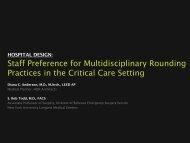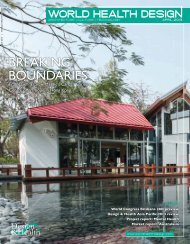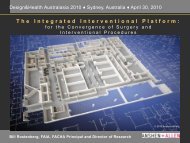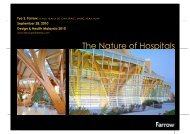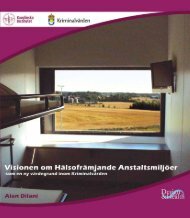<strong>Design</strong> & <strong>Health</strong> Scientific ReviewStreet vendor concentration nodes scattered throughout <strong>the</strong> central business districtAn important part <strong>of</strong> <strong>the</strong> environmental design plan isto ‘pedestrianise’ several streets in <strong>the</strong> CBD<strong>and</strong> 11 years. Vendors choose to engage inthis type <strong>of</strong> street occupation• They work long hours – 10 hours a day,Monday to Sunday – <strong>and</strong> earn only aboutUS$20 a week.The research siteBaguio City’s central business district issituated in a deep valley with four arterialstreets leading to it. In <strong>the</strong> early 1900s <strong>the</strong>location was selected by <strong>the</strong> Americancolonialists as a resting <strong>and</strong> healing place for<strong>the</strong>ir troops. Documents written by militaryphysicians have chronicled <strong>the</strong> positiveimpact <strong>of</strong> this upl<strong>and</strong> city on soldiers’ healthbecause <strong>of</strong> its high elevation <strong>and</strong> cool air.From a quiet convalescent place, Baguio Citytransformed throughout <strong>the</strong> centuries into abusy economic engine for <strong>the</strong> region.At <strong>the</strong> initial phase <strong>of</strong> this longitudinalstudy, <strong>the</strong> vendor spaces were measured,toge<strong>the</strong>r with sidewalk widths <strong>and</strong> o<strong>the</strong>rphysical attributes. The space metrics showthat 44% <strong>of</strong> vendors are located in relativelyfl at areas <strong>and</strong> 56% are sited on steepinclines 5 . Topography is an important factorin <strong>the</strong> entrapment <strong>of</strong> air pollution, which inturn affects health conditions.Ano<strong>the</strong>r signifi cant feature <strong>of</strong> <strong>the</strong> centralbusiness district is <strong>the</strong> high traffi c volume thathas exceeded its streets’ carrying capacity.Major colleges <strong>and</strong> universities, government<strong>of</strong>fi ces, as well as <strong>the</strong> city market, aremagnets that draw people <strong>and</strong> diesel-runvehicles to its centre. Idling vehicles in <strong>the</strong>l<strong>and</strong> basin <strong>and</strong> those running uphill on steepinclines contribute to <strong>the</strong> mix <strong>of</strong> polluted air<strong>and</strong> noise.Also important to this study <strong>of</strong> place <strong>and</strong>health is Baguio’s local climate. Elevatedat 5,000 feet above sea level, <strong>the</strong> cityexperiences temperatures ranging from10ºC during <strong>the</strong> cold months <strong>of</strong> December,January <strong>and</strong> February to around 30ºCduring <strong>the</strong> warm months <strong>of</strong> March, April<strong>and</strong> May. Cold temperatures <strong>of</strong>ten create aninversion effect that traps polluted air during<strong>the</strong> early mornings. Warm wea<strong>the</strong>r, on <strong>the</strong>o<strong>the</strong>r h<strong>and</strong>, <strong>of</strong>ten brings an onset <strong>of</strong> gastrointestinaldiseases because <strong>of</strong> food-bornebacteria found in non-refrigerated foodsthat vendors ei<strong>the</strong>r sell or pack from home.It is also known for its prolonged monsoonseason in which rainy wea<strong>the</strong>r is evidentfrom June to early September. During thisseason, a rise in <strong>the</strong> incidence <strong>of</strong> fl u <strong>and</strong>o<strong>the</strong>r respiratory problems is common.Vendor sites & urban architectureThe local spaces that hold vendors’microbusinesses are varied, interesting <strong>and</strong>indicative <strong>of</strong> socio-economic factors. Forexample, <strong>the</strong> vendors who have established<strong>the</strong>ir territories for many years are locatedin spaces that are mostly fl at <strong>and</strong> have highpedestrian traffi c. Relative newcomers areleft with secondary spaces in minor streetswith moderate foot traffi c. Vendors select<strong>the</strong>ir spaces based on <strong>the</strong> type <strong>of</strong> productssold, friendships <strong>and</strong> ethnic affi liation. Fruitvendors tend to settle in places adjacentto eateries while those selling hard goodslike t-shirts, DVDs <strong>and</strong> household productsare found close to banks <strong>and</strong> retail outlets.However, most, if not all, vendors use a part<strong>of</strong> <strong>the</strong> physical environment as a basis for<strong>the</strong>ir location decisions.The urban architecture found in centralBaguio City is characterised by diversebuilding types, uses <strong>and</strong> forms. Four- t<strong>of</strong>i ve-storied modern designed buildingsframe <strong>the</strong> main street. O<strong>the</strong>r buildings aremodest, with only three stories withordinary architecture.Building architecture impacts on <strong>the</strong>quality <strong>of</strong> vendor sites. For example, only25% <strong>of</strong> vendors are located under buildingoverhangs that span <strong>the</strong> entire sidewalk.In fact, about 32% <strong>of</strong> vendors are in sitesthat are not under any overhang. They areexposed to climactic elements like <strong>the</strong>monsoon rains <strong>and</strong> cold mountain air.Integral to urban architecture is <strong>the</strong>presence <strong>of</strong> sidewalks fronting <strong>the</strong> buildings.As <strong>the</strong> owners have responsibility forconstructing <strong>and</strong> maintaining sidewalks, <strong>the</strong>00 56 Summer October 2008 | WORLD HEALTH DESIGN
Urban <strong>Design</strong>infrastructure is included in <strong>the</strong> overall design<strong>of</strong> <strong>the</strong> property. This results in varying heights,widths <strong>and</strong> quality <strong>of</strong> sidewalks throughout<strong>the</strong> central business district. Sidewalk widthsvary from seven to 16 feet 6 . Sidewalkdensity, as measured by pedestrian counts<strong>and</strong> sidewalk widths, has an effect on healthconditions. Higher sidewalk densities createenvironments that encourage <strong>the</strong> spread<strong>of</strong> communicable diseases like infl uenza,bronchitis <strong>and</strong> pneumonia, especially during<strong>the</strong> monsoon season.Street vendors s<strong>of</strong>ten <strong>and</strong> personalise<strong>the</strong> existing architecture by creating workspaces made <strong>of</strong> simple materials to display<strong>the</strong>ir products <strong>and</strong> work ‘comfortably’ forten hours a day. Cartons <strong>and</strong> cardboardboxes make up fruit st<strong>and</strong>s <strong>and</strong> tarpsare used to display special items. O<strong>the</strong>rvendors use building walls as st<strong>and</strong>s forposters <strong>and</strong> magazines. The colourful array<strong>of</strong> products contributes to <strong>the</strong> fi ner textures<strong>of</strong> urban places.Air qualityIn 2004 <strong>the</strong> research team monitored <strong>and</strong>assessed <strong>the</strong> air quality in 30 populatedvendor sites <strong>and</strong> a fi xed site on <strong>the</strong> thirdfl oor <strong>of</strong> a building. Generally, <strong>the</strong> data showedelevated levels <strong>of</strong> pollution in many areasin <strong>the</strong> central business district. The data at<strong>the</strong> fi xed site also indicated that particulatematter concentrations were higher than <strong>the</strong>National Ambient Air Quality St<strong>and</strong>ardsused in <strong>the</strong> United States.Environmental factors such as buildingheight, distance to a stoplight, street widths,number <strong>of</strong> street lanes <strong>and</strong> topography, aswell as vehicular <strong>and</strong> pedestrian volume,were added to a group <strong>of</strong> o<strong>the</strong>r variablesin a regression analysis model but werenot found to be statistically signifi cant. Thefactors that contributed signifi cantly tostreet level pollution were traffi c volume<strong>and</strong> wind direction 7 .The built environment <strong>and</strong> healthIn his treatise On Airs, Waters, <strong>and</strong> Places,Hippocrates strongly links disease withplace, particularly, a community’s location<strong>and</strong> local climate 8 . This observation, thoughdeveloped centuries ago, has come full circleas scientists today accept <strong>the</strong> connectionbetween <strong>the</strong> physical environment <strong>and</strong>health. We have based this study <strong>of</strong> streetvendors on Hippocrates’ fi ndings but <strong>the</strong>discussion has been extended to include<strong>the</strong> impact <strong>of</strong> <strong>the</strong> built environment <strong>and</strong> airquality on health. The variables considered in<strong>the</strong> analyses were:Physical environment factors: slope;vehicular volume; vehicular movement(idling, moving uphill); pedestrian volume.Architecture <strong>and</strong> built environmentindicators: building height; building overhang;curb height; distance to a drainage hole;distance to a garbage disposal; <strong>and</strong> quality<strong>of</strong> <strong>the</strong> sidewalk.Air quality: morning <strong>and</strong> afternoonmonitoring <strong>of</strong>: particulate matter 2.5;particulate matter 10; <strong>and</strong> carbonmonoxide.<strong>Health</strong> variables: number <strong>of</strong> healthproblems experienced in 2003; type <strong>of</strong>health problems.ResultsUsing bivariate correlation tests, <strong>the</strong> resultsshowed <strong>the</strong> following patterns:Slope <strong>and</strong> health conditions: Acorrelation between slope <strong>and</strong> type <strong>of</strong>health condition was found to be signifi cant(r=0.344, p


